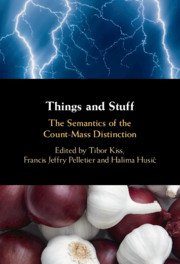Book contents
- Things and Stuff
- Things and Stuff
- Copyright page
- Dedication
- Contents
- Figures
- Tables
- Contributors and their Affiliations
- Preface
- 1 Editorial Introduction: Background to the Count–Mass Distinction
- Large-Scale Architectures for Count and Mass
- Implications from Individual Languages
- Compositional Analyses and Theoretical Issues
- New Empirical Approaches to the Semantics of the Count–Mass Distinction
- 14 The Role of Context and Cognition in Countability: A Psycholinguistic Account of Lexical Distributions
- 15 Plurality Without (Full) Countability: On Mass-Like Categories in Lexical Plurals
- 16 Determining Countability Classes
- 17 Polysemy and the Count–Mass Distinction: What Can We Derive from a Lexicon of Count and Mass Senses?
- References
- Language Index
- Subject Index
17 - Polysemy and the Count–Mass Distinction: What Can We Derive from a Lexicon of Count and Mass Senses?
from New Empirical Approaches to the Semantics of the Count–Mass Distinction
Published online by Cambridge University Press: 21 May 2021
- Things and Stuff
- Things and Stuff
- Copyright page
- Dedication
- Contents
- Figures
- Tables
- Contributors and their Affiliations
- Preface
- 1 Editorial Introduction: Background to the Count–Mass Distinction
- Large-Scale Architectures for Count and Mass
- Implications from Individual Languages
- Compositional Analyses and Theoretical Issues
- New Empirical Approaches to the Semantics of the Count–Mass Distinction
- 14 The Role of Context and Cognition in Countability: A Psycholinguistic Account of Lexical Distributions
- 15 Plurality Without (Full) Countability: On Mass-Like Categories in Lexical Plurals
- 16 Determining Countability Classes
- 17 Polysemy and the Count–Mass Distinction: What Can We Derive from a Lexicon of Count and Mass Senses?
- References
- Language Index
- Subject Index
Summary
In this paper, we discuss the implications for theories of the count/mass distinction that can be derived from the development of a large lexicon of English count and mass noun sense pairs, the Bochum English Countability Lexicon (BECL). The development of a lexicon for count and mass senses makes it possible that research on the count/mass distinction moves away from individual nouns and takes lexical variation into account. We focus on different types of ambiguity. The most important finding is that English shows a rather small class of nouns which are truly ambiguous with regard to the count/mass distinction, but not in any other respect. We suggest that these nouns show how the count/mass distinction is introduced into a language (which rests on the plausible assumption that all nouns begin their lives as mass nouns). The addition of denotational structure to provide individuation leads to an eventual petrification, which accounts for the somewhat surprising fact that there are many more count than mass nouns.
Keywords
- Type
- Chapter
- Information
- Things and StuffThe Semantics of the Count-Mass Distinction, pp. 377 - 397Publisher: Cambridge University PressPrint publication year: 2021
- 2
- Cited by



